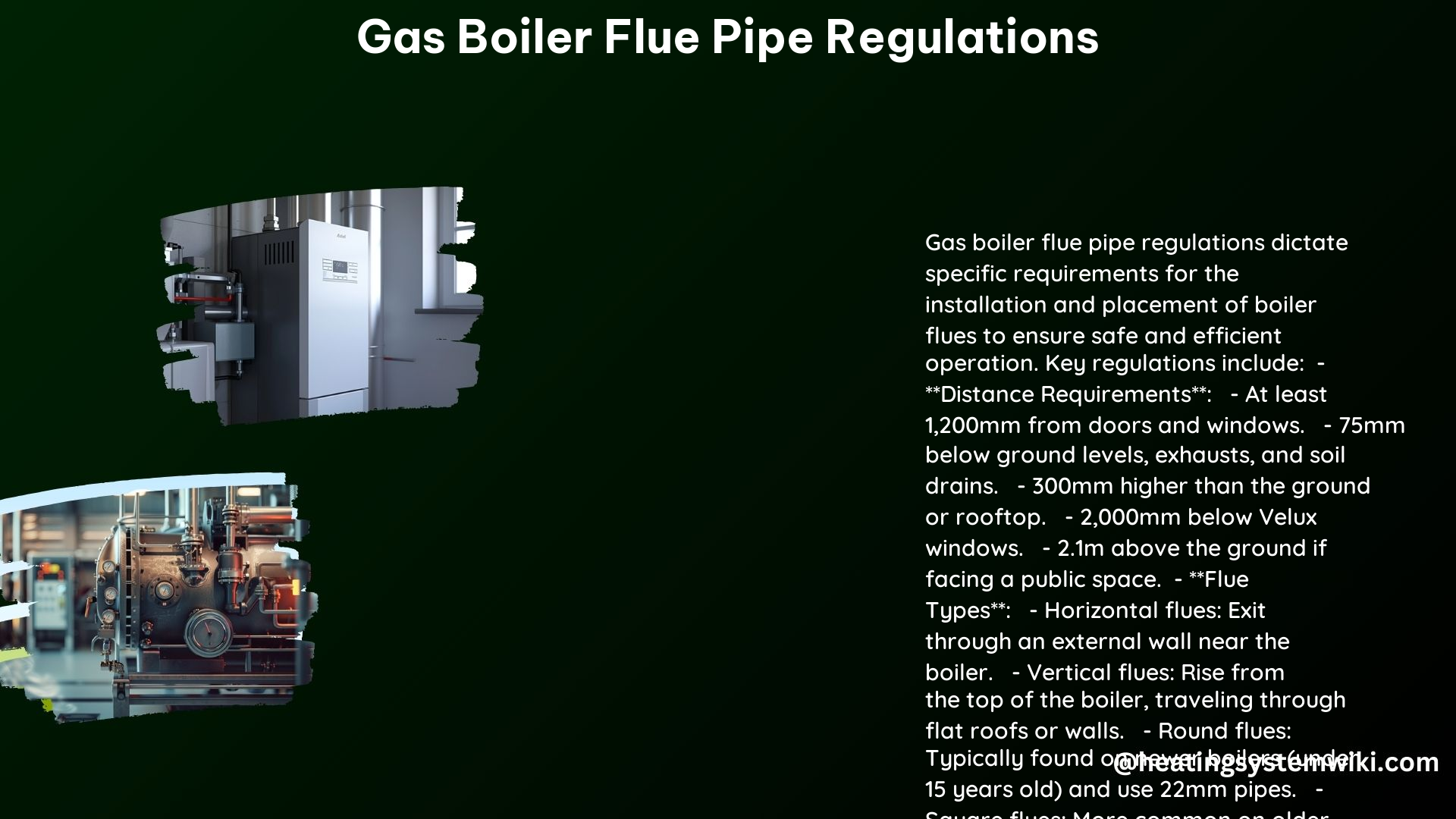Gas boiler flue pipe regulations are crucial for ensuring the safe and efficient operation of central heating systems. These regulations dictate the types of flue systems that can be installed, the materials and components required, and the placement and clearance requirements for flues. This comprehensive guide will delve into the technical details and provide a thorough understanding of the regulations to ensure your gas boiler installation and maintenance comply with the necessary standards.
Boiler Flue Regulations
Distance from Windows and Doors
The flue should be positioned at least 1,200mm (4 feet) away from any doors or windows. This distance is crucial to prevent the re-entry of waste gases into the property or affecting nearby buildings. The regulation is based on the principle of ensuring adequate dispersion and dilution of the exhaust, minimizing the risk of exposure to hazardous fumes.
Ground Level and Rooftop Clearance
The flue must be at least 300mm (1 foot) higher than the ground or rooftop level. This clearance is necessary to prevent the accumulation of waste gases near the ground or rooftop, which could pose a safety hazard. The regulation aims to facilitate the proper venting and dispersal of the exhaust, reducing the risk of exposure to harmful emissions.
Soil Drains and Exhausts
The flue should be positioned at least 75mm (3 inches) below ground levels, exhausts, and soil drains. This requirement ensures that the waste gases are not directed towards these areas, preventing potential contamination or interference with the proper functioning of these systems.
Velux Windows
If the flue is located near Velux windows, it must be positioned at least 2,000mm (6.5 feet) below the windows. This clearance is essential to prevent the waste gases from entering the property through these windows, which could compromise indoor air quality and pose a safety risk to the occupants.
Public Spaces
In cases where the flue faces a public space, such as a sidewalk or a street, it should be at least 2.1m (7 feet) above the ground level. This height requirement ensures that the waste gases are not directed towards pedestrians or passers-by, minimizing the risk of exposure and potential health hazards.
Flue Types and Materials

Round Flues
Round flues are typically found on newer boilers (under 15 years old) and utilize 22mm (7/8 inch) pipes. These flues are designed to meet the current regulations and are suitable for modern boiler installations. The round shape and larger diameter of the pipes provide improved airflow and efficient venting of the exhaust gases.
Square Flues
Square flues are more common on older boilers and use 15mm (5/8 inch) pipes. These flues may not comply with the latest regulations and may require replacement to ensure safe and efficient operation. The smaller diameter of the square flues can lead to restricted airflow and potential issues with the venting of exhaust gases.
Installation and Maintenance
Qualified Engineers
It is essential that only qualified and licensed engineers install or maintain boiler flues to ensure compliance with the relevant regulations. These professionals have the necessary expertise and training to properly assess the installation site, select the appropriate flue system, and ensure the safe and efficient operation of the gas boiler.
Annual Servicing
Regular servicing of the boiler flue is crucial to maintain its proper functioning and safety. It is recommended to have the flue inspected and serviced by a qualified engineer at least once a year. This annual maintenance helps identify any potential issues, such as blockages, damage, or deterioration, and allows for timely repairs or replacements to be made.
Compliance and Safety
New Installations
When installing a new gas boiler, it is mandatory that the entire system, including the flue, complies with the current regulations. This includes meeting the requirements for flue placement, efficiency standards, and any other relevant safety and performance criteria.
Existing Boilers
For existing gas boilers, immediate modifications to the flue system may not be necessary unless the system is deemed unsafe by a qualified engineer. However, it is important to monitor the condition of the flue and address any issues that arise to ensure the continued safe operation of the heating system.
Technical Specifications
Venting Categories
Gas boilers are classified into different venting categories based on their operating characteristics:
– Category I appliances operate at non-positive vent pressure and have an exhaust gas temperature of at least 140°F (60°C).
– Category II appliances operate with non-positive vent pressure and exhaust gas temperatures lower than the dew point.
– Category III appliances operate with positive vent pressure and above the dew point.
– Category IV appliances operate with positive vent pressure and exhaust gas temperatures below the dew point.
The appropriate venting category must be considered when selecting the flue system and materials to ensure compatibility and safe operation.
Vent Material Selection
The selection of the vent material for the gas boiler flue is crucial and must be based on the specific application and venting category. Factors such as temperature resistance, corrosion resistance, and compatibility with the boiler’s exhaust gases must be taken into account. Common vent materials include stainless steel, polypropylene, and aluminum, each with their own unique properties and suitability for different boiler types and installations.
By understanding the technical details and regulations surrounding gas boiler flue pipe installations, homeowners and professionals can ensure the safe and efficient operation of their central heating systems. Adhering to these guidelines and consulting with qualified engineers can help prevent potential safety hazards and maintain the optimal performance of the heating system.
References:
1. Smart Cover. (2022, June 29). Boiler Flue Regulations Explained | Simple Guide. Retrieved from https://smart-cover.co.uk/blogs/boiler-flue-regulations/
2. 24|7 Home Rescue. (2023, May 17). Overview Of Boiler Flue Regulations. Retrieved from https://247homerescue.co.uk/blog/boiler-flue-regulations/
3. Schebler Chimney. (n.d.). How to Avoid 9 Critical Boiler Venting Mistakes. Retrieved from https://scheblerchimney.com/how-to-avoid-9-critical-boiler-venting-mistakes/
4. Skills Training Group. (2024). Boiler Flue Regulations 2024: A Simple Guide. Retrieved from https://www.skillstg.co.uk/blog/boiler-flue-regulations/
5. Boiler Central. (n.d.). Boiler Flues – Ultimate Guide with Boiler Flue Regulations & Rules. Retrieved from https://www.boilercentral.com/guides/boiler-flues-everything-you-need-to-know-about-a-boiler-flue/
